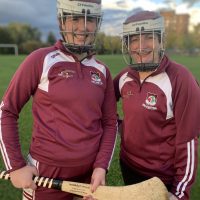Camogie Intro: the fastest women’s field sport

Camogie (ka-moe-gi) is an Irish team sport played by women on grass with a wooden stick (hurley) and a small ball called a sliotar (sli-ter). Camogie is played by 100,000 women in Ireland and worldwide, largely among Irish communities.
A variant of the game of hurling (which is played by men only) adapted to suit women, it is organised by the Dublin-based Camogie Association or An Cumann Camógaíochta.The annual All Ireland Camogie Championship has a record attendance of over 33,000, while average attendances in recent years are in the region of 15,000 to 18,000. The final is broadcast live, with a TV audience of as many as over 300,000 being claimed. UNESCO lists Camogie as an element of Intangible Cultural Heritage.
The origin of Camogie
The name of the sport, Camogie, was derived from the stick used in the game. From its inception, men played hurling using a curved stick called a camán in Irish. Women in the early camogie games used a shorter stick described by the diminutive form camóg. Today, both men and women use the same wooden stick known as a hurley although the length of the stick varies depending on the player’s height.
When the Gaelic Athletic Association was founded in 1884 the English-origin name “hurling” was given to the men’s game. When an organisation for women was set up in 1904, it was decided to anglicise the Irish name camógaíocht to camogie. The sport’s governing body, the Camogie Association or An Cumann Camógaíochta was founded in 1905 and re-constituted in 1911, 1923 and 1939. Until June 2010 it was known as Cumann Camógaíochta na nGael.
Camogie shares a number of aspects of the other main Irish sport, Gaelic football, such as the field and goals, number of players, skills and some terminology. It is typically played between two teams of 15 players on a rectangular grass pitch, although here in North America we play smaller sized games (often 9-aside) to suit the smaller sports facilities available.
How to Play
Two teams of 15 play in a 60-minute match (two thirty minutes halves). The objective of the game is for players to use a wooden stick to hit a small ball between the opponents’ goalposts, either over the crossbar, or under the crossbar into a net guarded by a goalkeeper.
The ball, called a sliotar, can be caught in the hand and carried for no more than four steps, struck into the air or along on the ground with the hurl. It can be kicked or slapped with an open hand for short-range passing.
A goal is scored when the ball goes between the posts and under the H-shaped bar. This is equal to three points. One point is scored when the ball goes over the bar.
As an example, the final score in the 2015 All-Ireland Championship Final was Cork 1-13 Galway 0-9. This means Cork won with one goal and 13 points (a total of 16 points) against Galway’s 9 points. Simple right?
Each team has 15 players on the field. Within the 15 players the team must consist of one goalkeeper, three full back players, three half back players, two centre-field players, three half forward players and three full forward players.
These number of players and the formation on the field will change depending on the size of the field available depending on if it accommodates 7, 9, 11 or 13-aside
Typically, in Ottawa we play with seven a side when playing indoor during the winter, and nine a side when playing outdoors during the summer and autumn months.
Unlike in other games where players from each team line up in their own half, players in Gaelic games including Camogie, Hurling and Gaelic Football start a game positioned on either side of the half, and pair themselves with an opposing team’s player.
You can see the official camogie rules in full here.
Starting the Game and Gaining Possession
The game begins with the Sliotar being rolled on the grass in between all four midfielders in the centre. Players will attempt to play the ball with their hurl along the ground in either direction, and towards a teammate. The player must use their Hurley to raise the ball of the ground and into their hands, they are not permitted to pick the ball up off the ground with their hand.
Players have four seconds or four steps to advance the ball while they hold it. After four steps, the player must either play the ball by striking the ball with their Hurley, or slapped with an open hand (the hand pass), or kicking it. Alternatively they can opt to bounce or balance the sliotar on the end of the hurley and a may move with the ball like this for as long as they can before either being dispossessed or passing the ball.
However, the player may only handle the ball twice with it is in their possession. Once the player has taken the ball into their hand a second time, they must play the ball without handling it again (pass or strike).
Losing Possession
The “block”, where one player attempts to smother an opposing player’s strike by trapping the ball between their hurley and the opponent’s swinging hurl
The “hook”, where a player approaches another player from a rear angle and attempts to catch the opponent’s hurley with their own at the top of the swing. Side-to-side charges are forbidden
How to score
In the game, two types of scores are possible: points (worth one point) and goals (worth 3 points).
A point is awarded for striking or hand-passing the ball over the crossbar, signalled by the umpire raising a white flag. A goal is awarded for striking or hand-passing the ball under the crossbar into the net, signalled by the umpire raising a green flag.
The fastest women’s field sport
Camogie is one of the family of 5 Gaelic Games – a purely amateur sport played at highly competitive levels – and has huge participation in Ireland. Out of the 600 Camogie clubs in the world, 560 are based on the island of Ireland. But you will find four provincial councils and affiliates in Asia, Australia, Britain, Europe, New York, the US – and right here in Canada. Those who have played other stick sports such as ice hockey, field hockey, ringette, baseball and softball have an interest and skills that easily transfer across.
Much like Hurling, Camogie has captured the imagination of many who watch the game for the first time. They are immediately drawn to with people the fast pace, skill and excitement of the fastest sport on grass.

The Ottawa Gaels are pleased to be introducing a Camogie Fall program in 2020. With support from Ireland’s Department of Foreign Affairs, Global Games Development Fund we are offering a Introduction to Camogie through weekly sessions in October (outdoors) at Celebration Park and in November/December (indoors) at the RA Centre.
All equipment provided and COVID protocols will be followed. More details to be provided once confirmed. Check back here and on our social media accounts.
Join us to try out this fun sport!




